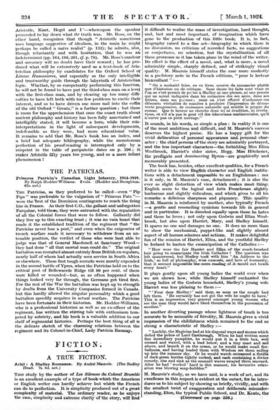THE PATRICIAS.
THE Patricias, as they preferred to be called.—even " Pip Pips " was preferable to the vulgarism of " Princess Pats "- were the 'first of the Dominion contingents to reach the firing line in France. As their first C.O., the gallant and unforgotten ' Farquhar, told-thees, they were entrusted withthareputation of all the Colonial forces that were to follow. Gallantly did they live up to this exacting trust ; it was no vain boast that made it the established tradition of the regiment that " the Patricias never lose a post," and even when the exigencies of trench warfare made it necessary to withdraw 'from an un- tenable position, the verdict of those who were best able to judge was that of General MacdonelL at Sanctuary Wood— they had done " all that mortal man could do." The original battalion was recruited almost entirely from British ex-regulars, nearly half of whom had actually seen service in South Africa or elsewhere. These first tough recruits were mostly expended in the second battle of Ypres, when the Patricias held on to the critical post of Bellewaerde Ridge. till 80 per cent. of them were killed or wounded—but, as so often happened when things looked very far through, the Germans got- tired fast,. For the rest of the War the battalion was kept up to strength by drafts from the University Companies formed in Canada. but this hardly altered the singular personality which a good battalion speedily acquires in actual warfare. The Patricias have been fortunate in their historian. Mr. Hodder-Williams, who is a professional historian as well as an ex-officer of the regiment, has written the stirring tale with enthusiasm tem- pered by sobriety, and his book is a valuable addition to our shelf of regimental histories. Perhaps the best thing of all is the delicate sketch of the charming relations between the regiment and its Colonel-in-Chief, Lady. Patricia.Ramsay.










































 Previous page
Previous page